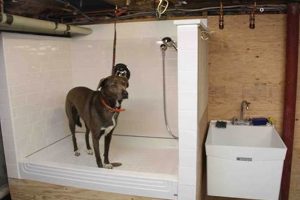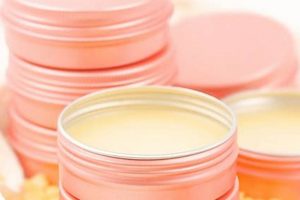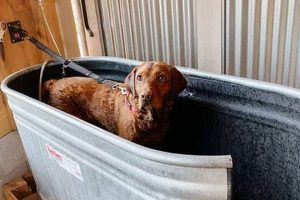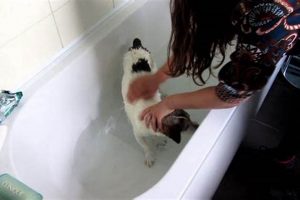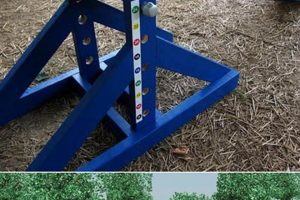Creating keepsakes featuring canine footprints offers a unique method of commemorating the bond between humans and their pets. These artistic endeavors involve capturing the impression of a dog’s paw using non-toxic materials and transforming it into a lasting visual representation, such as a painting or a framed print. An example includes pressing a paw onto a canvas coated with pet-safe paint to produce a personalized piece of wall decor.
The significance of such projects lies in their ability to preserve memories and celebrate the companionship provided by dogs. These handmade items serve as sentimental reminders of a beloved animal’s presence and can evoke strong emotional connections. Historically, imprints have been used across cultures to mark significant events and create tangible links to the past, and this practice extends to pet ownership through the creation of unique artworks.
The following sections will explore various techniques and material considerations for producing these paw-focused artistic creations. Guidance will be provided on selecting appropriate paints, preparing the canine participant, and ensuring a safe and enjoyable experience for both pet and owner. Furthermore, creative avenues for displaying and personalizing the finished pieces will be presented.
Guidance for Canine Footprint Art Creation
Achieving successful and aesthetically pleasing paw print art requires careful planning and execution. The following tips aim to provide a framework for creating lasting and meaningful keepsakes.
Tip 1: Prioritize Pet Safety: Employ only non-toxic, pet-safe paints specifically designed for animal use. Verify the paint’s composition and ensure it is easily washable to minimize potential skin irritation or ingestion risks.
Tip 2: Prepare the Canine Participant: Trim the dog’s nails before the activity to prevent scratching or uneven impressions. Acclimate the dog to having its paws handled and cleaned, using positive reinforcement techniques to minimize stress.
Tip 3: Select Appropriate Materials: Opt for high-quality canvases, papers, or other mediums that will withstand the paint and ensure longevity of the artwork. Consider the size of the dog’s paw when choosing the surface area.
Tip 4: Practice Patience and Timing: Select a time when the dog is relaxed and cooperative. Work quickly and efficiently to minimize the duration of the activity and reduce potential frustration for the animal.
Tip 5: Utilize Assistance When Necessary: Enlist the help of another individual to assist with holding the dog or guiding its paw during the printing process. This can improve accuracy and reduce the likelihood of smudges or incomplete impressions.
Tip 6: Thoroughly Clean the Paws: Immediately after creating the prints, thoroughly wash the dog’s paws with warm water and a mild soap to remove all traces of paint. Inspect the paws for any signs of irritation or redness.
Tip 7: Allow for Adequate Drying Time: Permit the finished artwork to dry completely in a well-ventilated area before handling or displaying it. This will prevent smudging and ensure the paint adheres properly to the chosen medium.
These guidelines promote a safe and rewarding experience, resulting in a cherished memento that captures the unique bond between owner and pet.
The subsequent discussion will cover creative avenues for enhancing and personalizing canine footprint art, providing further inspiration for crafting distinctive keepsakes.
1. Safety First
The principle of “Safety First” forms a cornerstone in the creation of paw print art. The potential risks associated with introducing foreign substances to an animal necessitate meticulous planning and execution. Specifically, the selection of non-toxic materials becomes paramount to prevent adverse reactions, such as skin irritation, allergic responses, or even ingestion poisoning. A direct causal relationship exists: failure to prioritize safety can lead to immediate harm to the animal involved. For example, using acrylic paints intended for human use could result in dermatitis or, if ingested, severe gastrointestinal distress. Therefore, “Safety First” is not merely a guideline, but a fundamental requirement to ensure ethical and responsible pet-related crafting.
Beyond material selection, “Safety First” also influences the overall methodology. The creation process must be managed to minimize stress and discomfort for the animal. This entails short sessions, positive reinforcement techniques, and careful handling of the paws. Consider a scenario where a dog displays signs of anxiety, such as panting or lip-licking. Ignoring these indicators and continuing the activity could result in a negative association, potentially leading to future resistance to paw handling, regardless of the context. Therefore, prioritizing the animal’s well-being is integral to the artistic process.
In summation, the concept of “Safety First” transcends a simple precaution; it is intrinsically linked to the viability and ethicality of paw print art. This approach not only protects the animal from potential harm but also ensures a positive and enjoyable experience for both pet and owner. By adhering to stringent safety protocols, the practice transforms from a potentially hazardous endeavor into a fulfilling and meaningful activity, resulting in a cherished keepsake created with responsibility and care.
2. Non-Toxic Materials
The creation of paw print art necessitates the exclusive use of non-toxic materials. This requirement stems directly from the potential for dermal contact and incidental ingestion by the canine participant. The paws, being sensitive and frequently licked, present a significant route of exposure to any applied substance. Consequently, the selection of paint, ink, or other coloring agents must prioritize formulations explicitly designed for animal use, ensuring the absence of harmful chemicals such as heavy metals, formaldehyde, or volatile organic compounds (VOCs). The causal relationship is clear: toxic materials pose a direct threat to the animal’s health, whereas non-toxic alternatives mitigate this risk.
The importance of non-toxic materials extends beyond immediate safety concerns. Long-term health considerations also warrant careful material selection. Chronic exposure to even low levels of certain toxins can accumulate over time, potentially leading to organ damage or other adverse health effects. For example, paints containing lead, while less common today, can still be found in older or imported art supplies and pose a severe risk if ingested, particularly for puppies. Furthermore, certain pigments, even in small quantities, may trigger allergic reactions or skin sensitivities in susceptible animals. Thus, the practical application of this understanding involves rigorous research and careful vetting of all materials before use.
In summary, the use of non-toxic materials is not merely a suggestion but a fundamental prerequisite for responsible paw print art creation. The selection of appropriate materials directly affects the safety and well-being of the animal. The failure to prioritize non-toxic options can lead to immediate or long-term health consequences. Therefore, creators must actively seek out and utilize materials specifically formulated for animal use, ensuring a safe and enjoyable experience for both the artist and the canine subject. This responsible approach reinforces the ethical considerations inherent in pet-related artistic endeavors and promotes the creation of lasting keepsakes without compromising animal welfare.
3. Patience Required
The element of “Patience Required” forms a critical, often underestimated, component within the realm of canine-centric artistic projects. Its significance transcends mere tolerance, encompassing a proactive and adaptable approach to the inherent unpredictability of working with a living subject. Without a foundational commitment to patience, the potential for frustration rises, negatively impacting both the artistic outcome and the animal’s well-being.
- Canine Cooperation Variability
A dog’s willingness to cooperate varies based on several factors, including breed, age, temperament, and previous experiences. Some dogs may readily accept paw handling, while others exhibit resistance or anxiety. For example, a young puppy, still in the socialization phase, might be more receptive to new experiences compared to an older dog with a history of negative interactions related to its paws. Therefore, the time required to achieve a successful paw print will differ significantly, necessitating a patient and adaptable approach.
- Environmental Distractions
The surrounding environment can significantly influence a dog’s focus and behavior. Noises, smells, or the presence of other animals or people can create distractions, diverting the dog’s attention and hindering the artistic process. A dog easily distracted by external stimuli, such as the sound of a doorbell or the sight of a squirrel, might require multiple attempts to obtain a clear paw print. Therefore, a controlled and calm environment, coupled with patient redirection, becomes crucial.
- Procedural Adaptations
The chosen technique for capturing the paw print may require adjustments based on the dog’s response. Some dogs might tolerate having their paws dipped in paint, while others might find it stressful. Alternatives, such as using a stamp pad or applying paint with a brush, might prove more effective. A dog resistant to having its paws dipped in paint might respond positively to a gentler application method. This necessitates flexibility and patience in adapting the procedure to suit the individual animal’s preferences.
- Minimizing Animal Stress
Patience directly correlates with minimizing stress for the dog. Rushing the process or forcing compliance can induce anxiety and create a negative association with paw handling. Observing the dog’s body language for signs of stress, such as panting, lip-licking, or tail tucking, is essential. When signs of discomfort are detected, pausing the activity and allowing the dog to calm down is paramount. This patient approach ensures that the artistic endeavor remains a positive and enriching experience for the animal.
These facets collectively highlight the indispensable role of patience in successful canine footprint art projects. The variable nature of canine behavior, coupled with potential environmental distractions and the need for procedural adaptations, necessitate a proactive and understanding approach. By prioritizing the animal’s well-being and adapting to its individual needs, creators can transform a potentially frustrating experience into a rewarding and meaningful artistic endeavor.
4. Preparation Key
Effective execution of canine paw print art hinges significantly on thorough preparation. This preparatory phase directly influences the quality of the final product and, more importantly, the safety and comfort of the animal. The absence of adequate preparation can lead to compromised artistic results, increased animal stress, and potential safety hazards. The connection between proactive preparation and successful canine paw print art is one of direct cause and effect. For example, failing to trim a dog’s nails before attempting to capture a paw print increases the likelihood of scratching the canvas or creating an uneven, undesirable impression. Similarly, neglecting to acclimate the dog to having its paws handled can result in anxiety and resistance, making the entire process significantly more challenging.
The practical significance of this understanding manifests in several critical areas. One essential element of preparation involves gathering all necessary materials beforehand. This includes pet-safe paint, cleaning supplies, a suitable canvas or paper, and treats for positive reinforcement. Having these items readily available minimizes delays and reduces the potential for distractions during the activity. Another crucial aspect entails creating a calm and controlled environment, free from external stimuli that might unsettle the dog. This might involve selecting a quiet room, minimizing noise levels, and ensuring that other pets or people are not present to create distractions. Thorough preparation extends to understanding the specific breed and temperament of the dog involved. Some breeds are naturally more tolerant of handling than others, and individual dogs may have unique sensitivities or preferences. Adapting the approach to suit the dog’s specific needs is paramount.
In conclusion, the principle of “Preparation Key” is not merely a suggestion, but an essential prerequisite for responsible and successful canine paw print art. By investing time and effort in thorough preparation, creators can minimize stress for the animal, optimize the artistic outcome, and ensure a safe and enjoyable experience for both pet and owner. This understanding underscores the importance of prioritizing animal welfare and approaching pet-related artistic endeavors with careful planning and consideration. The challenges associated with unpreparedness, such as compromised results and increased animal stress, highlight the practical significance of embracing a proactive and well-organized approach to canine paw print art.
5. Cleanliness Essential
The principle of “Cleanliness Essential” forms an indispensable element in the realm of “dog paw print art diy.” Maintaining a hygienic environment and ensuring the removal of art materials from the canine participant’s paws is not merely a procedural step but a fundamental requirement for both the animal’s health and the longevity of the created artwork. The following points elaborate on this critical aspect.
- Prevention of Irritation and Infection
Residue from paints, inks, or other art mediums can cause skin irritation or allergic reactions on a dog’s paws. Moreover, if not thoroughly removed, these substances can harbor bacteria, leading to potential infections, particularly if the dog has any existing cuts or abrasions. Complete removal of all art materials post-activity is therefore paramount to maintaining dermal health. For example, acrylic paints left on paws can dry and crack, causing discomfort and creating entry points for bacteria.
- Minimizing Ingestion Risks
Dogs naturally groom themselves, and their paws are frequently licked. Lingering art materials can be ingested during this grooming process, potentially leading to toxicity depending on the composition of the substance. Even if the materials are labeled as “non-toxic,” ingestion can still cause gastrointestinal upset. A failure to ensure thorough cleaning creates a direct pathway for harmful substances to enter the animal’s system.
- Preservation of Artwork Quality
The presence of dirt, debris, or residual oils on the dog’s paws before creating the print can compromise the clarity and definition of the artwork. These contaminants can create smudges, uneven impressions, or discoloration on the final product. Thoroughly cleaning the paws prior to applying paint or ink ensures a clean and consistent transfer, resulting in a higher-quality and more visually appealing artwork. For example, traces of mud can obscure the paw print’s details, reducing its aesthetic value.
- Maintaining a Hygienic Workspace
Paw print art, by its nature, can be a messy activity. The spread of paint or ink to surrounding surfaces is common. Maintaining a clean workspace throughout the process minimizes the risk of stains, cross-contamination, and the accidental transfer of art materials to other areas of the home. Furthermore, a clean workspace promotes a more organized and efficient artistic process.
These components highlight the crucial role of cleanliness. The need for pristine paws before printing and the necessity for immediate and total cleansing after, contribute greatly to the success and safety of dog paw print art. The connection between cleanliness and canine welfare is direct and unwavering, underscoring that this aspect of dog paw print art DIY merits utmost attention and care.
6. Creative Display
The method of “Creative Display” is intrinsically linked to the value and impact of canine paw print art. The act of creating such art is only partially complete without thoughtful consideration of how the finished piece will be presented and integrated into the owner’s living space. Display choices directly affect the emotional resonance of the artwork and its ability to serve as a lasting tribute to the animal. A poorly chosen display can diminish the artwork’s intended effect, while a carefully selected presentation can enhance its sentimental value and aesthetic appeal. For example, a paw print framed in a simple, elegant style and hung in a prominent location within the home serves as a constant reminder of the pet’s presence and the bond shared.
Practical applications of “Creative Display” range from traditional framing techniques to more unconventional methods. Framing remains a popular choice, allowing for the selection of matting and frame styles that complement the artwork and the surrounding decor. Other options include transferring the paw print image onto household items, such as mugs, coasters, or blankets, thereby integrating the pet’s memory into daily life. The use of digital images of the paw print to create personalized phone cases or calendars represents another avenue for creative expression. These diverse approaches demonstrate the adaptability of “Creative Display” and its capacity to personalize the remembrance of a beloved animal.
In summary, “Creative Display” is not merely an afterthought in the creation of canine paw print art, but an integral component that determines the artwork’s ultimate impact. Thoughtful presentation enhances the sentimental value and aesthetic appeal of the finished piece, transforming it into a cherished keepsake. Overcoming the challenge of selecting a display method that appropriately reflects the relationship with the pet underscores the importance of considering “Creative Display” as an essential element of the overall artistic endeavor. The connection between creation and presentation is crucial, ensuring that the resulting artwork serves as a fitting tribute to the animal’s memory.
7. Memorial Value
In the context of canine-focused artistic endeavors, the “Memorial Value” associated with paw print art transcends mere aesthetics, serving as a tangible representation of a deep emotional connection and a lasting tribute to a beloved companion. The creation of such art often occurs following the loss of a pet, transforming the activity into a grieving process and the finished piece into a significant memento.
- Tangible Remembrance of Physical Presence
Paw prints provide a physical connection to the deceased animal, capturing a unique aspect of its form. Unlike photographs or written memories, the paw print represents a direct impression, offering a tactile link to the pet’s physical presence. This is particularly poignant for individuals who find comfort in tangible reminders of their lost companion.
- Symbolic Representation of Unconditional Love
The paw print serves as a visual symbol of the unconditional love and companionship provided by the dog. The artwork becomes a constant reminder of the positive impact the animal had on the owner’s life, evoking memories of shared experiences and the unwavering bond between human and pet. It acts as a focal point for reflection and remembrance.
- Therapeutic Outlet for Grief Processing
Engaging in the creation of paw print art can offer a therapeutic outlet for processing grief. The act of carefully crafting the artwork allows for focused reflection and serves as a constructive means of channeling emotions. The process itself can be cathartic, providing a sense of closure and promoting emotional healing during a difficult time.
- Personalized and Unique Tribute
Paw print art offers a highly personalized and unique way to commemorate a pet’s life. The artwork can be customized to reflect the individual animal’s personality and the owner’s specific preferences. This personalization enhances the memorial value, creating a truly one-of-a-kind tribute that captures the essence of the relationship.
These aspects underscore the profound “Memorial Value” inherent in dog paw print art. The artistic process transforms from a mere crafting activity into a significant act of remembrance, providing solace and a lasting tribute to the enduring bond between humans and their canine companions. The unique combination of tangible representation, symbolic meaning, therapeutic outlet, and personalized expression renders such artwork a particularly meaningful way to honor the memory of a beloved pet.
Frequently Asked Questions
The following section addresses common inquiries regarding the creation of paw print art, providing guidance on safety, materials, and techniques.
Question 1: What types of paint are safe for use on a dog’s paws?
Only non-toxic, pet-safe paints specifically formulated for animal use should be employed. These paints are typically water-based and free from harmful chemicals such as heavy metals or formaldehyde. Always verify the product label to ensure it is suitable for pets.
Question 2: How can potential reactions to paint be minimized?
A small test patch of paint should be applied to a limited area of the dog’s paw and observed for any signs of irritation, redness, or swelling before proceeding with the full paw print. Prompt and thorough washing of the paws after the activity is also crucial.
Question 3: What is the best method for cleaning a dog’s paws after creating paw print art?
Warm water and a mild, pet-friendly soap should be used to gently wash the paws, ensuring that all traces of paint or ink are removed. A soft cloth or brush can aid in removing stubborn residue. Inspect the paws for any remaining pigment after washing.
Question 4: How to prepare a dog for paw print art, particularly if it is sensitive about its paws being touched?
Acclimatize the dog to having its paws handled through gradual and positive reinforcement. Begin by simply touching the paws briefly and rewarding the dog with treats and praise. Gradually increase the duration and pressure of the touch over time. Avoid forcing the dog if it exhibits signs of stress or discomfort.
Question 5: What other art medium options besides paint can be used?
Alternative mediums include non-toxic stamp pads specifically designed for pet use, or creating a mold of the paw using pet-safe clay or casting materials. Always ensure the chosen medium is safe for contact with the dog’s skin and cannot be harmful if ingested.
Question 6: How should paw print art be displayed to ensure its longevity and preservation?
The artwork should be stored in a dry, dark environment to prevent fading or discoloration. Framing the paw print behind UV-protective glass can further protect it from the damaging effects of sunlight. Avoid displaying the artwork in areas with high humidity or temperature fluctuations.
Prioritizing pet safety and meticulous execution are paramount. It is essential to use nontoxic and pet-safe mediums and be patient during the process.
The subsequent discussion will explore advanced techniques for customizing canine paw print art and transforming it into unique and personalized keepsakes.
Conclusion
The preceding exploration of dog paw print art diy has illuminated critical considerations for crafting meaningful and safe keepsakes. Prioritizing animal welfare through the use of non-toxic materials and patient execution is paramount. The memorial value inherent in these artistic endeavors underscores their significance as tangible representations of the human-animal bond.
Effective dog paw print art diy requires informed decision-making and responsible practices. By adhering to established safety guidelines and thoughtfully selecting display methods, individuals can create lasting tributes that honor the memory of their canine companions. Continued diligence in researching appropriate materials and techniques will ensure that these artistic endeavors remain a positive and ethically sound means of commemorating the human-animal connection.



